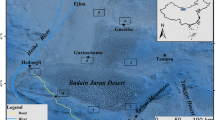Abstract
Direct gradient analysis was used to relate the structure of mangrove communities to soil nutrient gradients. The predominant cations in the alluvial soils were magnesium and calcium, the values ranging from 8.6±0.9 to 24.6±2.0 me per 100 g. Organic carbon was high in the soils, ranging from 3.5% to 10.4%. All soil nutrients varied seasonally, in response to wet and dry periods of the climate. Correlation of species with soil nutrients indicated the nutrient status of the soils to be best defined in terms of calcium for the A stratum (species > 3 m tall), calcium/postassium for the B stratum (species 1–3 m tall) and magnesium for the C stratum (species < 1 m tall). Ecological group classification shows that Avicennia africanaand Nypa fruticansoccurred almost exclusively at the highest calcium values of 20.8 and 17.6 me per 100 g, respectively. Acrostichum aureumand Sesuvium portulacastrumare insensitive to the magnesium gradient. The analysis revealed an overlapping range of occurrences for most of the species although with varying ecological optima along the gradient.
Similar content being viewed by others
References
Clarke, D.L. and Hannon, N.J. 1967. The mangrove swamps and salt marsh communities of the Sydney district I. Vegetation, soils and climate. Journal of Ecology 55: 752–771.
Cannor, D.J. 1969. Growth of grey mangrove (Avicennia marina) in nutrient culture. Biotropica 1: 36–40.
Ellenberg, H. 1956. Cited in Whittaker, R.H. 1967. Biological Review 49: 207–264.
Giglioli, M.E.C. and Thornton, I. 1965. The mangrove swamps of Keneba, lower Gambia river basin I. Descriptive notes on climate, the mangrove swamps and the physical composition of their soils. Journal of Applied Ecology 2: 81–104.
Hauser, D. 1974. Some problems in the use of stepwise regression techniques in geographical research. Canadian Geographer XVIII: 48–158.
Hesse, P. 1961. Some differences between the soils of Rhizophora and Avicennia mangrove swamps in Sierra Leone. Plant & Soil 14: 335–346.
Hynn-Cong-Tho and Egashira, K. 1976. Some chemical, physical and mineralogical properties of acid sulphate soils from the Mekong Delta in Vietnam. Journal of the Faculty of Agriculture, Kyushu University. 20: 151–164.
Jackson, M.L. 1962. Soil Chemical Analysis. Prentice-Hall, Englewood Cliffs, NJ.
Lugo, A.E. 1980. Mangrove ecosystems: successional or steady state? In: Tropical succession. Biotropica Suppl. 65–72.
Lugo, A.E. and Snedaker, S. 1974. The ecology of mangroves. Annual Review of Ecology and Systematics 5: 39–64.
Mueller-Dombois, D. and Ellenberg, H. 1974. Aims and Methods of Vegetation Ecology. Wiley, London.
Naidoo, G. 1980. Mangrove soils of the Beachwood area, Durban. Journal of South African Botany 46: 293–304.
Nigerian Meterological Services 1996. Climate data for Calabar airport, Lagos.
Thom, B.G. 1967. Mangrove ecology and deltaic geomorphology, Tobasco, Mexico. Journal of Ecology 55: 301–342.
Ukpong, I.E. 1992. The structure and soil relations of Avicennia mangrove swamps in southeastern Nigeria. Tropical Ecology 33: 1–16.
Ukpong, I.E. 1994. Soil-vegetation interrelationships of mangrove swamps as revealed by multivariate analysis. Geoderma 64: 167–181.
Ukpong, I.E. 1995a. Classification-analytic models for vegetation and nutrient relations of mangrove swamps in West Africa. Acta Botanica Hungarica 39: 17–29.
Ukpong, I.E. 1995b. Mangrove soils of the Creek Town Creek/Calabar river swamp, Southeastern Nigeria. Tropical Ecology 36: 103–115.
Ukpong, I.E. 1998. Relation between vegetation, soil nutrient content and salinity in an estuarine mangrove swamp in West Africa. Pol. J. Ecol. 46: 65–73.
Waring, R.H. and Major, J. 1964. Some vegetation of the California redwood region in relation to gradients of moisture, nutrients, light and temperature. Ecological Manographs 34: 167–215.
Whittaker, R.H. 1967. Gradient analysis of vegetation. Biological Review 49: 207–264.
Whittaker, R.H. 1978. Direct gradient analysis. In: Whittaker, R.H.(ed.), Ordination of plant communities. Handbook of vegetation science 5. Dr W. Junk, the Hague, The Netherlands.
Wikum, D.A. and Wali, M.K. 1974. Analysis of North Dakota gallery forest: vegetation in relation to topographic and soil gradients. Ecological Monographs 44: 441–464.
Author information
Authors and Affiliations
Rights and permissions
About this article
Cite this article
Ukpong, I.E. Ecological classification of Nigerian mangroves using soil nutrient gradient analysis. Wetlands Ecology and Management 8, 263–272 (2000). https://doi.org/10.1023/A:1008452923256
Issue Date:
DOI: https://doi.org/10.1023/A:1008452923256




